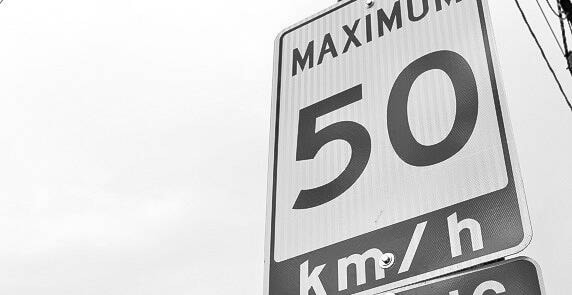Victoria will bring forward proposed bylaw changes that would lower speed limits to 30 km/h on some streets outside the city’s main transportation routes.
The measure would apply to residential areas, not major traffic-moving arteries, connector streets or downtown roadways (as listed here).
Reducing speed limits supports more livable and quieter neighbourhoods, and safer roads, a staff report said. Victoria’s proposal is motivated by lower speed limits proving to lower the chances of incidents turning fatal.
B.C.’s health ministry said vulnerable road users, like pedestrians, have an 85 per cent chance of death or serious injury if they’re hit by a vehicle going 50 km/h, but that falls to 10 per cent if they’re struck by one travelling 30 km/h or less. Children are seven times more likely to be hospitalized when struck by vehicles going 50 km/h compared to ones going 30 km/h.
In January, Victoria staff learned the minister of transportation wouldn’t be proceeding with speed limit reducing pilots and broader reforms to reduce default limits from 50 km/h to 30 km/h.
That means municipalities that want to slow residential streets have to do it through their bylaws. Doing that means communities will have to install signs on every single block where communities want to reduce the 50 km/h default.
Amending the bylaw would see 30 km/h signage roll out in a years-long process that would prioritize areas near schools, parks, roads without sidewalks and where city data shows speeding and problematic driving.
Coun. Geoff Young said he’d prefer a 40 km/h benchmark regionally and the city would be “virtue signalling” and it would be an “empty gesture” unless the newly signed areas weren’t matched with enforcement.
Staff said every street can’t be enforced 24/7 and the city shares data on problematic driving spots with police – which the city said focuses enforcement where the most serious crashes, speeding and dangerous driving occurs.
Other councillors pointed to the city’s goal of zero annual traffic deaths and injuries, and how its council’s responsibility to put public safety systems in place.
“I don’t see any need for going faster than 30 km/h on a local roadway where there could be kids playing street hockey or young children riding a bicycle,” Coun. Jeremy Loveday said.
Coun. Stephen Andrew, who at several points was critical of where staff got its data, asked why a study into pedestrian motor vehicle collisions (PMVC) on Toronto roads that adopted 30 km/h wasn’t looked at.
When staff later told him that study found a 28 per cent decrease in PMVC where the speed limit went from 40 to 30 km/h, the councillor said they needed to recheck their facts as he thought it was only a seven per cent drop. Staff’s figure was correct, while the seven per cent PMVC decrease Andrew mentioned actually referred to 40 km/h streets where there was no change.
Young, Andrew and Coun. Charlayne Thornton-Joe voted against bylaw amendments being prepared for future consideration.
READ: Victoria renames Trutch Street with Lekwungen word for ‘truth’
jake.romphf@blackpress.ca. Follow us on Instagram. Like us on Facebook and follow us on Twitter.
